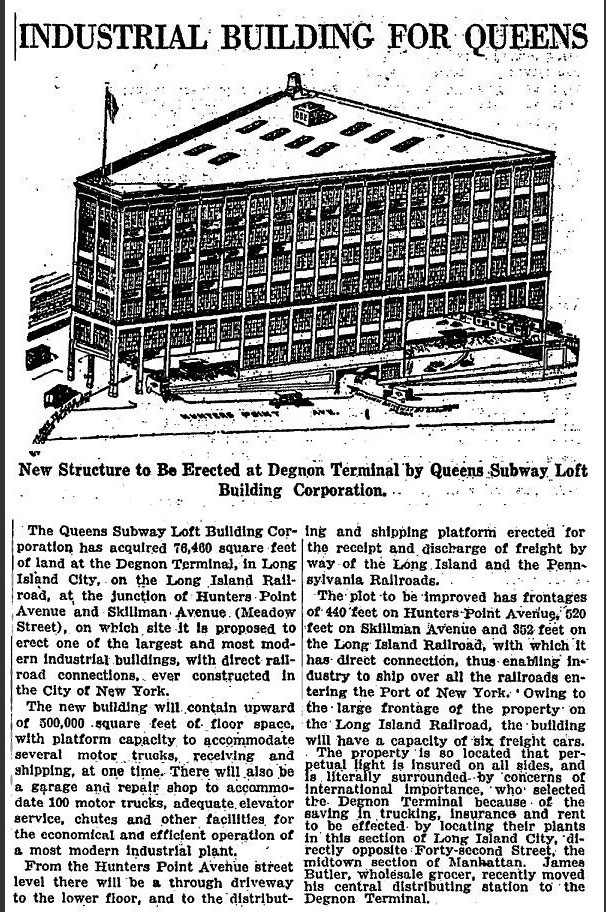
The curious case of the building and miniature railroad that was planned next to the Montauk Cutoff, yet never built.
History
Two weeks back, I noted that there were never any industrial customers who unloaded freight along the Montauk Cutoff. There was, however, a very bold plan to locate a large freight building along these tracks, where goods could be transloaded from trains to trucks (and vise versa).
The ‘Queens subway apartment and loft building’ was planned for the northeast corner of Hunterspoint avenue and Skillman avenue. This building would be triangle shaped, filling the odd-sized lot it would be placed upon. An article in the NY Times describes this new building in great detail, including 500,000 square feet of floor space, 7 floors, with space for 100 trucks and a siding with space for 6 railroad cars.
For unknown reasons, the building seems to have never been built.
For unknown reasons, the building seems to have never been built. The NYC dept of buildings has no record of it. The department of buildings issued a permit for a new building to be built here in 1940, though the first certificate of occupancy doesn’t show up until 1949. There’s another permit for a new building in 1953, and related COO dated 1954 which describes it as a 2 floor building containing warehouse and office space. This 2 floor building sounds like the building that is presently located on the site.
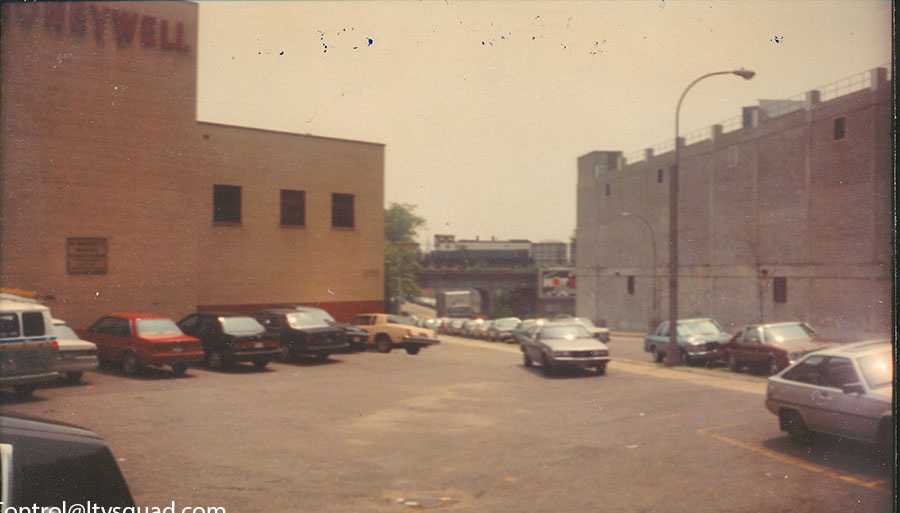
In this 1988 photo, the building is plainly labeled ‘Honeywell’. By the early 1990s, a courier company, sureway worldwide, was located within this building (after outgrowing a small warehouse on 32nd street off 26th avenue). In turn, sureway saw their customers dwindle in a highly competitive market. By the early 2000s sureway ceased to exist. The building was eventually re purposed to become the P4@skillman school.
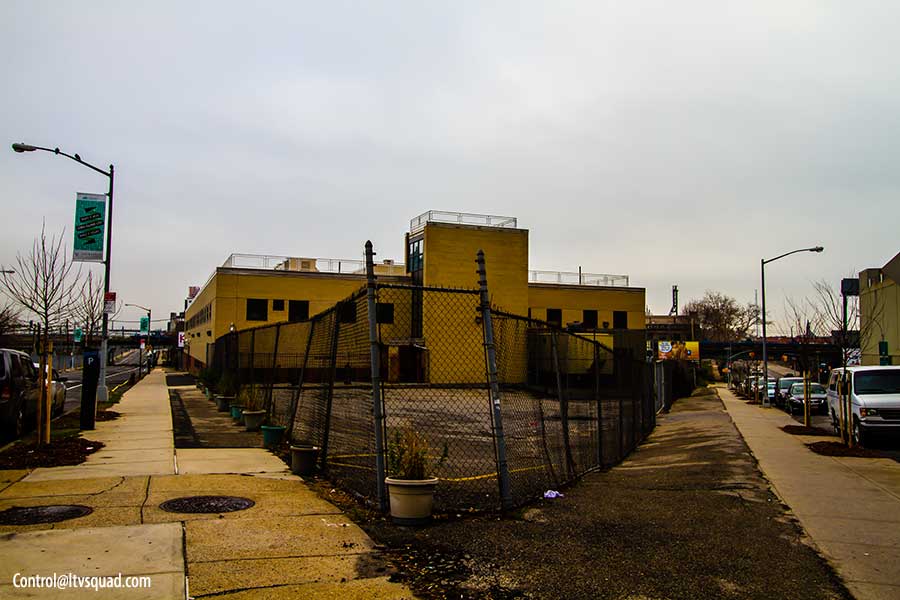
The circa 1940s building that was eventually built on the lot, seen in this dec. 2015 photo. it is presently the P4@Skillman school
Queens Subway Loft’s Legacy.
Today, there are only 2 known physical reminders of this building project. One is located in Maine, while the other is hidden in plain view.
1. The locomotive.
The loft apartments ordered 3 steam locomotives, built new by the Vulcan locomotive works. At least one of them is known to survive, in Rockport, Maine. Check out this page for a photo.
To make this matter all the more curious, the locomotive was a ‘narrow gauge’ model – built to run on tracks that are substantially narrower than those of the LIRR. For this type of locomotive to be useful, there would have needed to be separate tracks located somewhere. Locating them inside of the building wouldn’t have made sense for a coal-fired locomotive producing large amounts of exhaust.
It is unknown why this building ordered its own locomotives. With a siding along the Montauk cutoff, the Long Island Rail Road would have provided switching services. If street-level tracks were planned, the clearance of the Skillman and Hunterspoint avenue overpasses would have required tracks to come in from sunnyside yard – where again, the LIRR would have most likely provided switching services.
The nearby Degnon terminal had its own freight locomotives for switching at the time this building was proposed. They sold their locomotives and allowed the LIRR to provide switching services along these tracks (until they were abandoned in the mid-to-late 1980s).
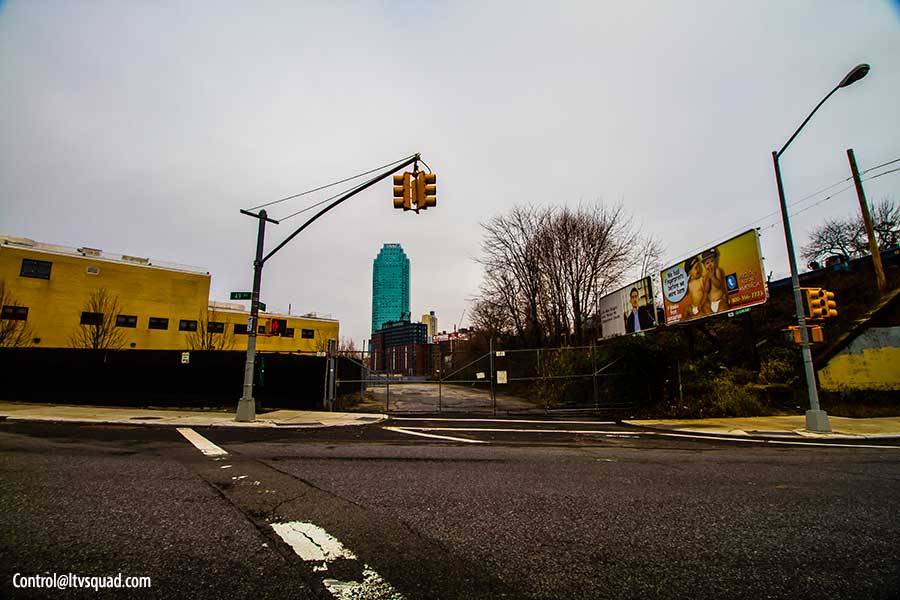
Fenced in parking lot where Heyward / 25th street was de-mapped
2. Hayward Street.
Hayward street was a north-south thoroughfare running along the western edge of the Montauk Cutoff. Today it is better known as 25th street. The last block of the northern end of this street – between Hunterspoint avenue and Skillman avenue/Meadow Street , was “de-mapped’ on June 9nd, 1922, with control of the property handed to the Queens Loft corporation for $112.50 (plus a $2000 insurance bond). The land that the street sat on would have been needed to allow the rear of the building to be flush against the Montauk Cutoff – where the freight train siding (presumably) would have been located.
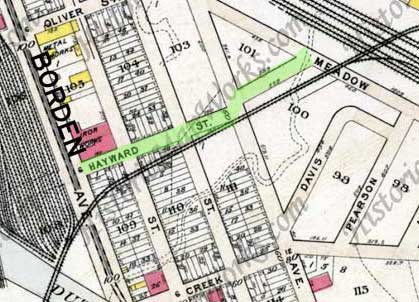
Historic map showing Hayward street highlighted in green – continuing between Skillman (meadow) and Hunterspoint avenues.
Tying it together: The Degnon Connection.
Michael Degnon was the director of the Queens subway apartment and loft corporation. He may have been it’s sole owner. Degnon had bought the parcel of land that the loft building was to be located upon years before, and apparently transferred it to this new corporate entity. Degnon is actually listed as director of 10 other separate corporations, one of which was a lead contractor in the construction of the present day 4/5/6 IRT subway tunnels in lower Manhattan. He had previously worked for a railroad, and in his own words “Before I was twenty-two I did all sorts of work, from laborer up to Superintendent of Construction.”
One could guess that the locomotives for this loft building were merely ordered by the queens apartment and loft corporation as a matter of bookkeeping – never actually intended for use at this location. As a man leading a company with millions of dollars in construction contracts, who had spent his whole life building railroads, he would surely have a use for such locomotives, somewhere.
“Apartment and Loft?”
I believe the ‘apartment’ portion of the Queens subway apartment and loft company’ refers to a few other properties that were owned by this Degnon operated shell company. One can only guess the ‘subway’ portion of the name refers to the nearby #7 subway route.
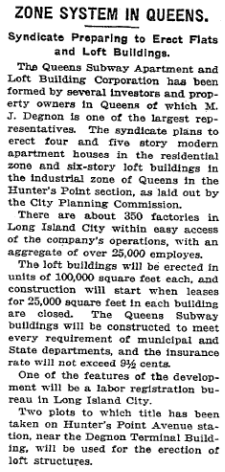
This above article actually hints at why perhaps this building was never built: construction was only set to begin when leases for over 25,000 square feet were signed. Perhaps an industry was never found to occupy enough of the building to make it worth the construction costs? This seems odd, considering the migration of factories from Manhattan to Queens at the time. Maybe the property was just held to drive up the value of neighboring properties.
Clearly Michael Degnon had achieved quite a bit of success in his life, though for whatever reason the Queens apartment and subway loft building never got past the planning stages. I get the impression this is just a minor footnote in his legacy, which I’ll save for a post about the Degnon terminal itself.
What If?
If this building had been built, it may have made for a busy transload business that might still be active today (all of the rail customers at Wheelspur are transload). An active customer would likely have required the LIRR/MTA/NY&A to continue freight service on the Montauk Cutoff. Just like the old Marvel comics ‘what if’ series – it’s interesting to ponder, but reality is what it is.
Leave a Reply